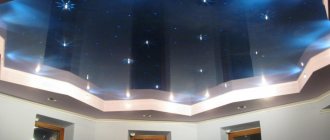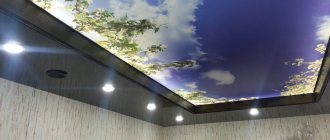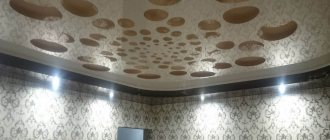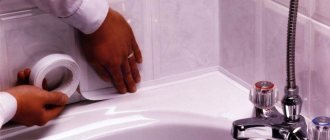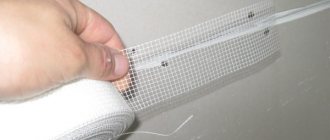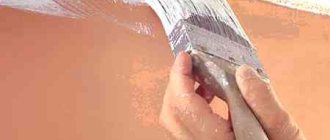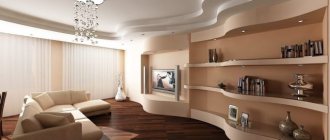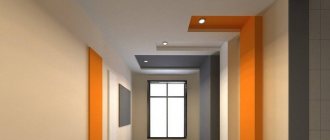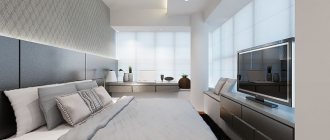Every home owner dreams of having a perfectly flat ceiling, so many people choose tension structures. The stretched fabric will hide any surface imperfections and will look better than many finishing materials. But after the entire structure is installed, a gap becomes noticeable between the edge of the ceiling and the wall. To hide it, you need to install masking tape. But why should you choose it and not a standard ceiling plinth?
Is it necessary to install masking tape?
Masking tape for suspended ceilings is installed after the installation process of the structure without applying glue. The gap between the elastic sheet and the wall occurs due to the fact that the material is attached to special profiles, inside of which there is a cavity. It is this that becomes visible after the installation process. To hide it you need to use special inserts. If you leave the structure without this element, it will look unfinished. Installing the insert is just as necessary as creating the baseboard when installing wood floors.
But there are also alternative, rarely used types of elastic:
-SL, for those with iron fingers. It’s a joke, of course, but it’s worth getting used to installing such a tape. Its design differs from popular inserts; rather, it is close to a separating tape. Not suitable for all wall moldings, you need to select them.
- wall corner. This is also a rather specific type of plug. It should only be installed on perfectly prepared walls and a high-quality screwed profile.
- Christmas tree. An alternative to the SL tape is the herringbone plug; it is much easier to install, looks nicer, and costs more.
It’s impossible to say unequivocally that corner, herringbone and SL are bad ribbons. They’re just not that common, I solve my own specific problems, and sometimes they help out a lot.
For example, when the back shelf of a baguette is puttied or pressed tightly into the wall insulation, then the herringbone is simply irreplaceable.
But for everyday editing I still prefer TL and TLP.
Choosing between masking tape and ceiling plinth
After installing the structure, some may think about installing a standard ceiling plinth. But before that, you should consider the features of its use:
- The plinth is mounted only on the walls. This means that such an element will not be held securely. Because of this, you will have to buy a very wide baseboard.
- This element makes it difficult to repair the tension fabric structure. When replacing the tension fabric, the apartment owner will have to peel off all the baseboards.
It is worth noting that for such a case it is better to choose a molding that is suitable for mounting to the wall. The advantage of the product in question is that after installing the masking tape for a stretch ceiling, it can be easily removed. This may be necessary when replacing communications above the canvas or in case of flooding of the apartment from above.
Due to the ease of installation, the camouflage insert can be installed in a short time, without having the skills to work with tension structures. This element can be easily pulled out during repairs.
If ceiling plinths are installed, they must be thrown away after dismantling. In this case, there will be a need to eliminate defects in the wall surface after work. By using a masking insert, all these problems can be avoided.
The advantage of this product over skirting boards is that it is flexible, so even when installed near an uneven wall, it can be easily installed without defects appearing on the surface.
Options for ropes for suspended ceilings: photo
Although decorative ropes intended for PVC sheets have appeared on the market of goods and services relatively recently, they are presented in a wide range, which allows you to choose the appropriate option for decorating a room in any style.
The cords may differ in diameter. The following options are available for sale:
- 1.5 mm;
- 8 mm;
- 10 mm;
- 14 mm.
In addition to different diameters, decorative elements differ in the weaving method used in the production process, in material, and color scheme.
In addition, hoops for stretched PVC fabrics may include additional inserts:
- inclusions using cotton or rubber veins;
- there may be a strong core made of metal wire;
- plain braid may be included;
- presence of colored braiding.
In addition, it is worth considering that ceiling ropes can be either monochrome or multi-colored. In addition, the material often contains woven threads that imitate silver or gold.
During the manufacturing process, the manufacturer can use the following types of edges:
- twisted;
- knitted;
- wicker
In some cases, patterns can be viewed on the surface of the material, which are obtained through the use of multi-colored threads during production.
Advice! If necessary, you can see how ropes instead of ceiling skirting boards look in the photo in the interior design.
Pros of masking tapes
To be sure that it is better to use masking tapes for a tension structure, you should consider their advantages:
- Easy to install. For installation, simply place the insert in the groove and secure it.
- Compactness. Unlike decorative edging for suspended ceilings, the tape is not capable of visually noticeably lowering the structure, since after installation it becomes a continuation of the surface.
- Versatility. This feature lies in the fact that the inserts can be used for tension structures from different manufacturers.
- A large number of models of different colors and shapes. Even if there is no tape of a certain shade, the product can be painted yourself.
- Can be used more than once. After dismantling, the ceiling plinth can be replaced with a new one, and the appearance and shape of the insert remain the same even after long-term use.
- Flexibility. This advantage facilitates the installation of tapes even in those places where the line of the tension web is not level.
- Tight fit to the wall and ceiling. Thanks to this, the insert prevents the appearance of dust in the gap and helps maintain the health of the apartment's inhabitants.
- Low cost. Unlike expensive moldings and baseboards, the camouflage insert is cheap, but this does not in any way affect its quality. To install such an element, you do not need to buy glue, which also helps save money.
- Decorative element. Despite the simplicity and practicality of such products, they can complement the interior if the apartment owner chooses the right color.
- Reliability. Due to the fact that the insert is made of elastic material, it can serve for a long time and retain its original appearance. This means that even after several years it will not fall out of the groove and will remain as strong as when installed.
But before installing masking tape on a suspended ceiling, you should remember that its disadvantage is the impossibility of running hidden wiring through it.
Cord
One such option is a thick textile cord; it perfectly masks the gap. The twisted cord is just as easy to install into the mounting groove. It is used not so much to mask the gap, but as an independent decorative element of the interior.
Attention: when inserting the cord into the profile groove, do not use a spatula or other sharp objects; they can easily damage the stretched fabric.
Installing masking tape
The main advantage of such a camouflage element is that it is attached without the help of glue and therefore does not spoil the surface of the ceiling and walls. This decorative insert can also be used to hide the joints between several panels of a tension structure.
The tape can have several shapes, since an L-shaped product is required for a corner, and a T-shaped product for insertion between several canvases. The first named type is the most versatile, since it can even be used as a plug for plasterboard ceilings.
To install the tape, it is enough to consider its structure and determine which side should be inserted into the profile. Such elements have notches that are adapted to connect with the protrusions of the plastic element of the stretch ceiling. This means that it will not be difficult to guess which side to insert it. In the case of a joint between several webs of a tension structure, insertion is also simple. To do this, you need to install two inserts side by side. After inspecting the tape, it is simply pressed into the gap between the wall and the ceiling using any thin, but not sharp, object.
In stores that sell suspended ceilings and their accessories, you can find many color options for such parts, so they can be matched to any shade of the surface. Typically, inserts are purchased to match the color of the walls, since their fold is below the plane of the ceiling. But there are products that are made in two colors.
How to choose
The only principle for selecting a decorative cord is the features of your interior. A minimalist or discreet design involves a monochromatic finish. A little silver sparkle can refresh the atmosphere and bring something new to it.
If the apartment involves lush decoration - beautiful carpets and curtains, an abundance of decorative elements, paintings - then the color scheme of the ceiling can be wider. Cords with a catchy gold or mother-of-pearl tint are allowed. With all the variety of colors, cords of soft colors are most often used: white, pastel, black.
Interiors look fresh and original not only with decorative cords that match the ceiling or lighting, but also with contrasting ones.
Previously, decorative cords were used only as curtain ties or furniture decoration elements, but today they have found their application in the decoration of ceilings. They make the decor truly exclusive and bring into the room an atmosphere of comfort, which is simply necessary for a modern person to relax and recuperate.
Types of tapes
Masking tapes for stretch ceilings can be of 3 types:
- T-shaped. They are used for installation in gaps next to smooth walls.
- L-shaped. This type is used for walls with unevenness, so all models are made of flexible material. During installation, they follow the relief of the wall.
- Connecting tapes are used when it is necessary to hide the gap between the joined strips of a stretch ceiling.
- Ribbons of different shapes. Such products repeat the bends of the stretch fabric.
Divider insert
To connect two canvases, a special connecting (separating) profile is used. After installing the ceilings, a centimeter gap remains, which is precisely closed by the dividing tape. These are Model R and R-mini. There are many who produce it, but you should be careful; the tape and profile of different manufacturers may not fit together.
Not a big life hack: if the separating plug is difficult to fit into the profile, then try cutting its chamber from the back side. After this, it will snap into place noticeably easier.
Plug for level profiles
Here you need to decide which profile will be used.
There are aluminum profiles for R-type plugs. Almost any separating pad will fit there.
There are also level profiles for LED strip. Such designs come with their own special translucent matte silicone plug.
